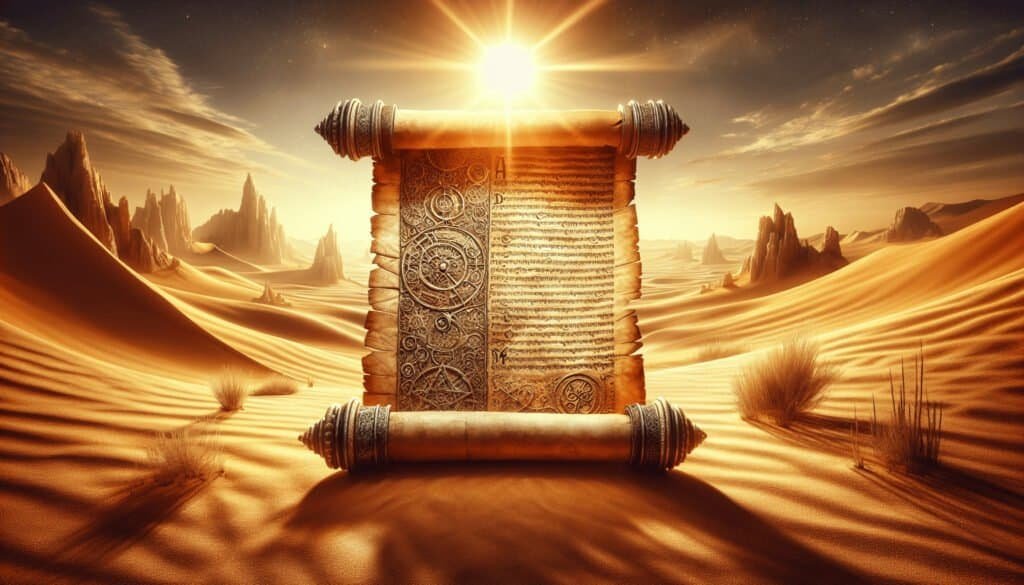What do you think of when you hear the term “Desert Library”? Does it conjure images of ancient scrolls nestled in sun-bleached caves, or perhaps the stirring verses of long-forgotten poets echoing through arid landscapes? Imagine setting out on a journey where poetry meets archaeology, revealing treasures that alter the very fabric of history. Today, you’re about to uncover the poetic treasures hidden within this remarkable intersection of biblical lore and the artifacts of time.
The Allure of Biblical Poetry
Biblical poetry holds a distinctive charm, doesn’t it? Its rhythm and imagery create vivid tapestries that resonate through the ages. You might think of the Psalms, which are fundamentally a collection of heartfelt cries to God, or even the Book of Lamentations, which resonates with the echoes of sorrow and resilience. Each piece speaks volumes about the human experience, wrapping intricate emotions in lovely verse.
Varieties of Biblical Poetic Forms
Biblical poetry encompasses various forms, each possessing its unique flavor:
Parallelism: This technique involves repeating or contrasting ideas for emphasis. It’s what gives biblical verses their lyrical quality. You might find it in Psalms, where the second line enhances or contrasts the first.
Imagery and Symbolism: The use of metaphors and similes transforms abstract ideas into concrete images. This is particularly evident in the Song of Songs, where love and nature intertwine beautifully.
Acrostics: This literary device utilizes the letters of the Hebrew alphabet to start each line or stanza, as seen in Psalm 119. It’s like a poetic puzzle that adds layers to the reading experience.
Over time, these forms captured the emotional landscape of various authors, showcasing their personal struggles, societal events, and theological questions. You see the weight of history and culture embedded in their verses.
The Desert Library: A Historical Context
Now, let’s take a step back and consider the concept of a “Desert Library”. This term doesn’t just invoke a mere collection of scrolls; it embodies the significance of ancient knowledge hidden within the rugged terrain of the Near East. The deserts of Israel and Jordan are steeped in history, acting as a natural vault for one of the most significant archaeological discoveries of the 20th century: the Dead Sea Scrolls.
The Dead Sea Scrolls: An Overview
Discovered between 1947 and 1956 in a series of caves near the Dead Sea, the scrolls are a treasure trove of biblical manuscripts, religious texts, and secular writings. They date back to the third century BCE to the first century CE, representing an extraordinary mosaic of early biblical history and cultural influences.
Significance: The scrolls provide insight into the textual history of the Hebrew Bible, revealing variants and helping scholars understand how biblical texts evolved over centuries.
Cultural Insights: Beyond biblical texts, the scrolls include commentaries and community rules of the Essenes, a sect believed to have lived near Qumran. This helps paint a rich picture of the religious and cultural dynamics of the time.
As you learn about the scrolls, you’ll realize they bear testament to the enduring human quest for meaning, faith, and community, reflecting the wonderfully complex interplay between religion and literature.

Into the Dust: Tracing The Trader’s Route
Let’s shift gears for a moment and follow the so-called “Trader’s Route,” the ancient trade paths that crisscrossed through the deserts of the Near East. These routes weren’t merely passages for goods; they were arteries of culture and ideas, facilitating the flow of not just merchandise but also literature, poetry, and spirituality.
Historical Trade Routes
The primary routes that traders followed were vital in shaping the historic landscape. Here’s a simplified view of the major trade networks:
| Route Name | Areas Covered | Key Goods Traded |
|---|---|---|
| Silk Road | Asia to the Mediterranean | Silk, spices, precious stones |
| Incense Route | Arabia to the Mediterranean | Incense, myrrh, spices |
| Spice Route | Southeast Asia to Europe | Spices, textiles |
| King’s Highway | Jordan Valley to Egypt | Grain, wine, oil |
These ancient paths not only facilitated commerce but also enabled the exchange of philosophical, religious, and literary ideas. You can imagine merchants pausing in dusty encampments to share tales of their journeys, reciting poetry that reflected the joys and struggles of life.
The Cultural Exchange of Ideas
By participating in this intricate web of trading, people—whether they were merchants, poets, or pilgrims—traded more than materials; they exchanged stories and ideas. Consider how biblical poetry likely traveled along these routes. Through oral traditions and written texts, tales of faith, love, despair, and hope trickled into the hearts and minds of people from diverse backgrounds.
This exchange contributed to the rich tapestry of biblical literature, blending different cultural influences and poetic expressions.
The Intersection of Poetic Tradition and Archaeology
You might find it interesting that studying biblical poetry alongside archaeological findings can yield profound insights into the context in which these poems were composed. The tangible remnants of the past—pottery shards, ancient tools, and, of course, scrolls—bring life to the verses themselves.
Archaeological Discoveries and Their Impact
When you look at archaeological findings, you’re peering into the lives of the past. For example, when exploring Qumran, the site believed to be associated with the Essenes, you can envision a community dedicated to preserving sacred texts. Here’s how their discoveries enhanced our understanding:
Material Culture: Items found alongside the scrolls, such as pottery and coins, allow us to date and contextualize the texts. They provide a glimpse into daily life, helping you imagine the community’s rituals surrounding the creation of these works.
Linguistic Insights: The language and writing styles found on the scrolls reveal connections with other ancient texts, showing how biblical poetry was not crafted in isolation but rather within a larger literary milieu.
By piecing together these findings, scholars can draw connections between historical events and the poetic expressions that arose in response to them. It’s a beautiful union of the poetic and the material, each informing the other in a dance through time.

Biblical Poetry’s Reflection on Cultural Identity
As you immerse yourself in biblical poetry, it becomes evident that these texts are reflections of cultural identity. They are expressions of hope, faith, and humanity’s enduring struggle against adversities, preserving collective memories across generations.
Themes within Biblical Poetry
Several themes resonate throughout biblical poetry, echoing the sentiments of the times they were created:
Suffering and Redemption: In the face of historical suffering—exile, conquest, and persecution—poets articulated the deepest frustrations and hopes of their people. The Book of Job, for example, embodies this exploration, questioning the nature of suffering and divine justice.
Love and Desire: The Song of Songs represents a lyrical celebration of love, intertwining physical desire with spiritual reverence. The longing expressed in its verses transcends time, resonating with universal human experiences.
Divine Majesty: Many psalms extol the attributes of God, weaving in natural imagery that emphasizes His grandeur, often reflecting the awe-inspiring landscapes of the desert. Such expressions foster a profound sense of connection between the divine and humanity.
This diverse array of themes enriches your understanding of how people in ancient times grappled with their experiences, crafting poetic forms that resonate even today.
Bridging Ancient Contexts and Modern Perspectives
And now, as you navigate through ancient verses and archaeological discussions, you might wonder how these insights from the past have relevance in our contemporary world. The beauty of biblical poetry lies not only in its historical significance but in its ability to resonate with modern experiences.
Modern Applications of Ancient Wisdom
How do you see this ancient wisdom manifesting itself today? Here are a few reflections:
Literature and Art: The essence of biblical poetry has transcended time, influencing countless writers and artists. From John Milton to contemporary poets, these ancient verses continue to inspire creative expressions and deepen our appreciation for literary artistry.
Spirituality and Reflection: The themes found in biblical poetry echo in many spiritual practices today, as individuals seek to express their struggles, joys, and hopes in the face of adversity. Reading or reciting poetry can be a comforting ritual that connects hearts with the transcendent.
Cultural Dialogue: Engaging with biblical poetry fosters dialogue about cultural identity and human experience, bridging gaps across different communities. These texts provide common ground for discussions about faith, resilience, and the complexities of human existence.
You might find it fascinating how the threads of ancient poetry weave into the fabric of our everyday lives, encouraging you to find your voice in the ongoing narrative of humanity.
Summary: A Journey Worth Taking
In wrapping up your journey alongside biblical poetry, the Desert Library reveals a treasure trove of insights and reflections that enrich your understanding of human history, culture, and spirituality. The interplay of commerce, community, and poetic form intertwines in an intricate dance, preserving voices from ages past.
The Dead Sea Scrolls, the trader’s routes, and the poetry that emerges from it speak of more than just ancient texts; they narrate the enduring human experience—our quests, desires, and the unyielding search for meaning.
As you consider the legacies of these poetic treasures, remember that they aren’t just relics of an ancient past; they are vibrant expressions inviting every single one of us to find resonance in their timeless themes. You are, indeed, part of this ongoing story, and your own reflections can contribute beautifully to the rich tapestry of human experience that spans centuries. Your exploration of these ancient texts can illuminate pathways for modern conversations about identity, faith, and the profound nature of emotion that connects us all.


